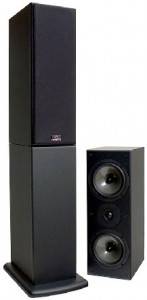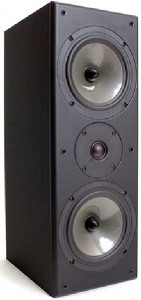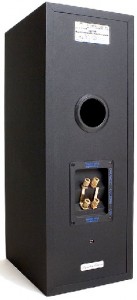Specifications
- Typical In-Room Frequency Response 45Hz – 20kHz +/- 3dB
- In-Room Sensitivity 92dB @ 1 watt / 1 meter
- Frequency Response (Anechoic) 48Hz – 24kHz +/- 3dB
- Sensitivity (Anechoic) 90dB @ 1 watt/ 1 meter
- Average Impedance 8 ohms
- Minimum Recommended Power 35 watts Maximum Continous Power 240 watts Maximum Short Term Peak Power 400 watts Cabinet Internally Braced 5/8″ MDF, Magnetically Shielded, Bass Reflex via Rear Tuned Port Dimensions H x W x D (grill on) 21″ x 7.5″ x 10.5″
- Dimensions H x W x D (with stands) 45″ x 10″ x 14″ Weight (each) 26 lbs. each
- Tweeter: (1) High-definition 27mm soft dome tweeter w/ damping chamber and wide roll surround, ferrofluid damped voice coil, wide dispersion faceplate, magnetically shielded
- Woofer (2) proprietary 6.5″ long throw polygel cone woofers w/phase plug, non-resonant polymer chassis, rubber surround, shielded
- Connectors (4) gold plated all metal 5 way binding posts, bi-wire ready.
- Price $568/pair, optional stands $140/pair
Without question, the best fast food restaurant in the Western U.S. is In ‘n’ Out Burger. They consistently deliver the freshest, best quality ground beef sandwiches available within arm’s reach of your driver’s-side window. Their secret? Focus. Their entire menu consists of just three items: the Hamburger with onions, the Cheeseburger with onions, and the Double Double. Optionally, you can get fries, a soda, or a shake. That’s it. No chicken, no fish filets, no burritos or chipotle bacon ciabatta whatever…they just keep it simple, and do it right.
If speaker companies were fast food restaurants, Ascend Acoustics would be In ‘n’ Out Burger. Ascend was started in February of 2000 by an experienced team of audio pros (head honcho Dave Fabrikant is a veteran of M&K Sound) with the goal of providing the highest possible sound quality at the most affordable price. Since then they have added but three products to their line up: a compact sealed speaker (the HTM-200), an award winning 6.5″ bookshelf speaker (the CBM-170 SE), and its larger sibling, the MTM-aligned CMT-340 SE.
Ascend Acoustics CMT-340 SE review
The original version of the CMT-340 was released in 2003, three years after the birth of the much-lauded CBM-170. Both were redesigned last year and given the “SE” distinction (meaning “special edition”). Most of the SE improvements were to the drivers (Ascend designs their own drivers but has them built by outside vendors: the tweeters by SEAS of Norway, the woofers by a manufacturer that Fabrikant has agreed not to name). The tweeter was completely redesigned, resulting in improved frequency response in both directions; and a new cone material was developed for the woofers, allowing better bass performance with lower distortion.
Not Exactly Love at First Sight
To be honest, I didn’t think much of the CMT-340s when they first came out of the box. Built out of 5/8″ MDF, they’re not particularly heavy, and barely passed the “knuckle rap” test. Also, and maybe I’m getting spoiled by AV123’s gorgeous veneers, but for $568 a pair I was somewhat put out by the Ascend’s unremarkable black “orange peel” texture vinyl finish.
If the build quality of the 340s was cause for concern, the matching stands were cause for alarm. These are basically hollow boxes made from even lighter 1/2″ MDF and the same black vinyl siding, albeit with a set of good quality brass spikes.
Mind you, they don’t look bad, and even though their black vinyl finish matches nothing in my living room, at only 7.5″ wide they don’t really stand out. The 340s are technically mini-towers (21″ tall), but when mounted on the stands they certainly look the part of floorstanding tower speakers, rivaling in appearance most anything you can find at a typical big box electronics chain.
Don’t Judge a Book by its Cover
…or a set of speakers by its cheap vinyl finish. I positioned the CMT-340s according to manual’s (very specific) directions: 2 feet from the wall behind them, 7.3 feet apart, toed in directly at the listening position 10 feet away. Once I put on some music, I went slackjawed…I was struck immediately by the 340s articulate sound, with a detailed, airy presentation I’ve only thought possible with much more expensive speakers.
At first, I did notice a slight boxy coloration in the mids. It was subtle, but would stand out for the first few minutes of each listening session…after that my ears would adjust and the coloration seemed to fade. I suspected a cabinet resonance, and fired off an email to Dave to ask what he thought. The cabinets, it turns out, are braced and damped in very specific (and effective) ways; he thought the culprit was probably the stands, which he strongly recommended be filled with sand or shot. The only requirement was that the material be thoroughly dry, as moisture is an enemy of MDF. One trip to Home Depot later and each stand was filled with 50 lbs. of kiln-dried playground sand (total cost around $10)…and I haven’t heard that boxy coloration since. Gone also was any notion of the 340s dedicated stands being lightweight or inadequate for the task…at 50 lbs. each, they are now the most solid fixtures in my system.
The CMT-340s highs have a crisp presence that is extended without being overbearing. The bass is tight and tuneful, not bleeding into the lower mids at all. This could make them sound bass shy to some, but I assure you the bass is there (flat to below 50Hz in my room), it just doesn’t make itself known unless specifically called upon. Still, the 340s benefit greatly from the addition of a subwoofer…I used a single Onix x-sub (easily the most musical sub you’ll find for $200) for the majority of my listening tests.
As nice as the 340s bass & treble are, their pièce de résistance is the midrange. Neutral but lively, this seems to be the heart of where the Ascends’ detail lies. The new CMT-340 SE drivers use a new light-mass cone material Ascend calls “polygel”, which, according to Fabrikant, “combined with the advanced motor assembly used and a real phase plug (which eliminates compression caused by a dust cap) allows the woofer to reproduce fast and accurate transients.” That means when the amplifier tells the speaker to stop playing, it stops… quickly. Subtle details (like the guitar pick scraping the string just before the note sounds) are kept intact, as are the even more subtle sonic clues that make up accurate imaging and soundstage.
This gives the 340s a level of detail that is precise but nonfatiguing. I was able to listen to the 340s for hours on end, and I never found them unmusical or uninvolving. A good example of this was with Led Zeppelin II…a recording with a boatload of raw rock ‘n’ roll energy, but a fair helping of studio artifacts as well. Clinical sounding speakers will call so much attention to the latter that you miss out on the former, but this was not the case with the Ascends. While they made the musical (and nonmusical) detail in the recording clearly audible, they presented this rock classic with enough guts that it practically begged to be turned up. When I did, they gave it back to me in spades, hitting volume levels that got my fist pumping and head banging even in my 13×20 foot living room. Of course, speakers capable of demonstrating such nuance do far more than rock. An audiophile acquaintance of mine recently turned me on to Holly Cole’s album of Tom Waits covers, Temptation. “Unless your speakers are up to it, it sounds like something is missing from this recording,” he advised. I first gave it a spin at work, with a pair of $25 headphones1 plugged in to the side of my laptop. Something was indeed missing, and I wondered just what all the fuss was about this recording. When I came home and cued it up on the Ascends, however, Cole’s vocals came to life, and her band’s deeply understated sense of groove bubbled to the surface.
The CMT-340s are particularly effective on large ensemble recordings, quite often the bane of smaller speakers, which can have trouble keeping up during complex musical passages. One of my favorite moments with them was with Paquito D’Rivera’s powerful Portraits of Cuba, a Chesky SACD with particularly good recording quality. I had it playing loud in the living room one night while attempting to clean the kitchen one room away…I was continually pulled back into the living room, as I was repeatedly convinced there was a 14-piece Cuban horn band in my house!
David Murray, for my money the world’s greatest living saxophone player, has long been a noteworthy composer and arranger as well. This is demonstrated powerfully on his Octet recordings, where he has always managed to make his band sound bigger that it really is. This illusion wasn’t lost when listening to Murray’s classic Home (Black Saint 120055) on the Ascends. However, they presented the music with more space around each musician than I’ve previously heard, which gave me new insights into the brilliant timbral and harmonic contrasts Murray uses to get his “big band” sound.
The same can be said for symphonic recordings…I was transfixed hearing specific instrument placements in Fritz Reiner and the Chicago Symphony Orchestra’s Also Sprach Zarathustra (RCA Living Stereo, SACD). The
340s also did an excellent job with the schizophrenic dynamics of Berlioz’ Symphonie Fantastique (Mercury Living Presence, SACD), in particular the dramatic tympani/oboe duet section near the end of the 3rd movement, and the chaotic finale. I did detect a bit of congestion near the end of the 1st movement, where I couldn’t quite hear each individual mallet strike in some of the more complex tympani work, however this could just as well be room sound from the original masters (the performance was recorded, after all, in 1959…in a Detroit high school auditorium).
Room sound is a big part of avant-garde alto sax player Jemeel Moondoc’s Spirit House (Eremite 029), recorded live in Bezanson Recital Hall at the University of Massachusetts, Amherst. The naturally-recorded reverb present in the hall was portrayed realistically, making for a particularly life-like listening experience…I found myself clapping after the solos! The spirited performance gets a bit cacophonic at times, especially during two conducted group improvisations, but the 340s projected a consistent, stable image of each of the 10 musicians position on stage (7 horns plus a guitar, bass & drum rhythm section), making the complex music easier to follow.
Comparisons
During my time with the Ascends, I borrowed a pair of the highly-regarded Von Schweikert VR-1s from a friend. The VR-1s are mini monitors, but at nearly twice the price of the 340s, I thought they would make good competition.
In a beauty contest, the VR-1s would walk away with the rhinestone-encrusted tiara in a heartbeat. The least expensive of Von Schweikert’s venerable line, they sport the same light maple veneer available on their five and six-figure models, and 45° chamfered edges give them a touch of class that the Ascends don’t attempt.
When the lights went down and the music came on, however, these two were much more difficult to tell apart. Both were obviously voiced with neutrality in mind, and each arrived close enough to the goal that I was unable to pick a favorite. The VR-1s have more extended bass, which gave a solidity and weightiness to their lower midrange presentation that bested the 340s during full-range listening, but this advantage diminished with the use of a subwoofer. The VR-1s also threw a wider soundstage, and boasted a smoother top-end (although I’m not 100% convinced that this “smoothness” was anything more than treble roll-off).
Although the Ascends’ more punchy upper mids made the Steinway Model D on Keith Jarrett’s Carnegie Hall Concert and the Bösendorfer Imperial on Clark Terry’s One on Onesound a tad bright (two pianos not normally known for being bright), they brought a welcome presence to vocals, guitar, saxophone, trumpet, etc. that the more polite VR-1s lacked. Also, the 340s are 3db more efficient in-room (according to both manufacturer’s specs), and with double the midrange cone area, are capable of playing a good deal louder before running out of steam.
I don’t really know which speaker had the most neutral, uncolored presentation, as I wasn’t there for the final mixdown of any of the recordings I own. I found most of the differences between these two sets of speakers to be just that: differences, and one could make a case for either speaker based on individual priorities. It is entirely possible that higher quality electronics could reveal subtle refinements in the VR-1s more clearly, but overall I found that while the Ascends may not be giant killers, they can stand comfortably in their presence without embarrassment.
Conclusions about CMT-340
The longer I spend with the CMT-340s, the more convinced I am that Ascend got the recipe absolutely right: a perfect combination of quality sound, transparency, and value. These are serious speakers…probably the most “no nonsense” I’ve ever had in my system. They won’t pass for fine furniture, and they won’t caress your ears with sweet, tubey warmth. If either of these is something you’re looking for, look elsewhere. What the Ascends are great at is providing a clear window into your recordings, and they do it in a lively, dynamic way. These are speakers I could live with for a very long time.
1. Sennheiser HD-201s. While they certainly fall into the category of cheap headphones, these are actually an incredible bargain, and sound leagues better than anything I’ve heard in the price range (they make a noticeable improvement over the stock iPod earbuds). $25 is $25 however, and they’re only going to take you so far.
external link: Ascend Acoustics CMT-340 official page
from affordableaudio, By Clarke Robinson
Ascend Acoustics Manufacturer’s Comments
Thanks for the review, Clarke and I am pleased that you enjoyed the speakers. I think it is important to note that in order to deliver this level of performance at this price point, compromises are necessary. Most (if not all) loudspeaker manufacturers allocate the bulk of production costs to the cabinetry and finish.
Our approach is a bit different in that the majority of our production costs are spent on the “guts” of the loudspeaker, namely the proprietary drivers and advanced crossover — the components that we feel matter most. For those consumers who desire a less discrete and fancier finish, we offer gorgeous custom finishing options for an additional fee. David Fabrikant



